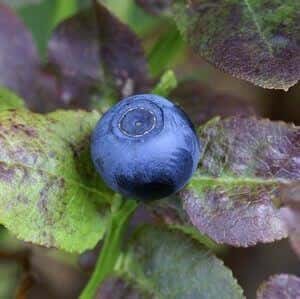
“Bilberry” sounds a lot like “blueberry,” and for good reason. The bilberry is a European blueberry. American blueberries are Vaccinium corymbosum. Huckleberries and whortleberries are also closely related.
Although blueberries in the United States are noted primarily for their excellent contributions to pies and jam, in Europe the dried fruit has long been considered an excellent treatment for simple diarrhea. As blueberry pickers may know, imbibing in too many fresh berries may have the opposite effect.
Bilberries have had a long-standing reputation as being good for night vision. Royal Air Force pilots ate bilberry preserves before flying night missions during World War II. This medicinal food should be investigated further; preliminary studies of bilberry extract hint at several benefits for vision. In general, however, the parts of the plant used medicinally are the dried fruits and the leaves.
Active Ingredients
Early analyses indicated that dried bilberries contained up to 10 percent tannins, which would certainly explain their effectiveness against diarrhea. More modern methods reveal only about 1.5 percent of the fruit content is tannins. The berries do contain significant amounts of pectin, which may also contribute to calming diarrhea. Other important constituents include anthocyanidins, invert sugar and fruit acids.
Flavonoids include quercitrin, isoquercitrin, hyperoside, and astragaline. The anthocyanidins may be important in supporting night vision, while the specific contributions of other constituents to the medicinal activity of bilberry have not been identified. The leaves are rich in manganese and chromium and very high in tannins, ranging from 10 to 20 percent.
Bilberry Uses
The traditional use for bilberry is to take the dried fruit for mild diarrhea. The berries are administered either whole, in which case they are chewed and swallowed, or as tea.
It is important that the fruit be dried; fresh fruit is ineffective or even counterproductive. Dried blueberries might work, however.
Europeans have also used a preparation of bilberry topically to treat sore throats and mild inflammation in the mouth. An extract of bilberry with 25 percent anthocyanidins is reported to protect blood vessels and prevent swelling due to inflammation. Research in rabbits and rats suggests that such an extract can reduce blood vessel permeability and help protect against some of the effects of high blood pressure.
Extracts are used in Europe to treat hemorrhoids and varicose veins in pregnant women and the elderly. One specific anthocyanidin pigment seems to protect the stomach of laboratory animals from experimentally induced ulcers without affecting stomach acid secretion. Instead, the pigment appears to stimulate the production of a protective prostaglandin.
Anthocyanidins have strong antioxidant activity. Preliminary studies suggest that an extract high in anthocyanidins can improve night vision and may slow the development of macular degeneration or cataracts. It has been suggested as a treatment to help prevent diabetic retinopathy. Further investigation is needed to confirm these benefits.
Like dried bilberries, the dried leaves of the plant have also been used in a tea to treat mild diarrhea or as a gargle for sore throat. Bilberry leaves have a reputation for being able to lower blood sugar in diabetes, and their high chromium content suggests that they might indeed offer some benefit. Good clinical studies are needed to investigate this possibility.
Bilberry Dose
The usual dose of dried bilberries is approximately 3 tablespoons a day. To make the tea, boil 1 tablespoon (roughly 10 g) of crushed dried fruits in water for about ten minutes and then strain before drinking. Maximum daily dose is 60 g of dried berries. In the form of an extract, take 240 to 480 mg daily standardized to 25 percent anthocyanosides, in divided doses.
To make a bilberry leaf tea, pour boiling water over about 1 and 1/2 teaspoons of dried leaves, steep for five or ten minutes, and strain. Bilberry tea should not be used as an herbal medicine for more than three or four days. If diarrhea persists, medical attention is required.
Special Precautions
No special precautions are known for bilberry fruit.
Any diabetic who decides to try a bilberry leaf decoction despite the lack of evidence that it is effective should be using other effective treatments and closely monitoring blood sugar.
Adverse Effects
No side effects of dried bilberries have been reported in the literature.
Bilberry leaves may cause serious problems in experimental animals administered large doses over a long time. In one experiment, the animals stopped eating, developed anemia and jaundice, became agitated, and eventually died. It is possible that the leaves they were given had been adulterated with leaves from another plant. These serious consequences are enough to suggest, however, that people should not take high doses of bilberry leaf over a long term.
Bilberry Possible Interactions
No interactions have been reported with bilberries. Because of the high levels of tannins in bilberry leaf, however, it is possible that it could interfere with the absorption of iron.

